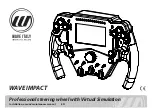
the FPGA and provides high-bandwidth memory that you can use in your LabVIEW FPGA
application.
Find DRAM memory integrity and memory throughput examples for LabVIEW FPGA in the
NI Example Finder. The NI Example Finder is located on the Help menu in the
LabVIEW
Help
.
Refer to the specifications on
for the DRAM density and the maximum
theoretical bandwidth. Refer to
LabVIEW Help
for information on effectively using the
DRAM interface.
Internal Real-Time Clock
The cRIO-9034 contains an internal real-time clock that maintains system time when the
cRIO-9034 is powered off. The system clock of the cRIO-9034 is synchronized with the
internal real-time clock at startup. You can set the real-time clock using the BIOS setup utility
or MAX, or you can set the clock programmatically using LabVIEW.
Refer to the specifications on
for the real-time clock accuracy specifications.
CMOS Battery
The cRIO-9034 contains a CMOS battery. The CMOS battery is a lithium cell battery that
stores the system clock information when the cRIO-9034 is powered off. There is only a slight
drain on the CMOS battery when power is applied to the cRIO-9034 power connector. The
rate at which the CMOS battery drains when power is disconnected depends on the ambient
storage temperature. For longer battery life, store the cRIO-9034 at a cooler temperature and
apply power to the power connector. Refer to the specifications on
for the
expected battery lifetime.
The
CMOS BATTERY IS DEAD
warning appears onscreen during the power-on self test if the
battery is dead. The cRIO-9034 still starts, but the system clock is reset to the date and time of
the BIOS release. The battery is not user-replaceable. If you need to replace the CMOS
battery, contact NI. Refer to the specifications on
for information about
battery disposal.
File System
LabVIEW mounts USB devices and SD cards to the
media/sdx1
directory and creates
symbolic links
/u
,
/v
,
/w
, or
/x
to the media mount point, starting with
/u
if it is available.
To prevent any file corruption to external storage devices, verify that any file IO operations
with the specific drive finish before removing the device. Refer to the
LabVIEW Help
for more
information.
The file system of the cRIO-9034 follows conventions established for UNIX-style operating
systems. Other LabVIEW Real-Time targets follow Microsoft Windows-style conventions. In
order to facilitate the porting of applications from those targets, this target supports the
Windows-style
/C
home directory. This path is bound to the UNIX-style directory
/home/
lvuser
.
Various LabVIEW Real-Time system files which would be accessible from
C:
(or
/C
) on
other LabVIEW Real-Time targets are found in different locations on this target.
NI cRIO-9034 User Manual
|
© National Instruments
|
21
















































